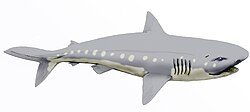Top Qs
Timeline
Chat
Perspective
Hesseltal Formation
Geological formation in Germany From Wikipedia, the free encyclopedia
Remove ads
The Hesseltal Formation or Blackcoloured Formation is a Late Cretaceous (late Cenomanian to early Turonian) geological formation from northern Germany. It consists of lithified marls and limestone, with a unique series of black shales deposited in anoxic conditions during the Cenomanian-Turonian boundary event.[1][2][3][4][5][6]
It provides an important record of the fauna of the proto-North Sea basin. The formation's diversity of fossil fish is thought to be due to a consequence of an expanding oxygen minimum zone that caused mass mortalities among different communities of fish, including both those associated with warm surface waters and those associated with colder waters from upwelling. The anoxic conditions allowed for detailed preservation of some of these fish, including bony fish with their stomach contents preserved and even a few partial body fossils of cartilaginous fish.[5][7] Fossil ammonites with preserved soft parts are also known.[8]
The formation's deposition also documents the Plenus Cold Event, an enigmatic, brief but severe cooling event that occurred during the otherwise rapid global warming from the Cenomanian-Turonian boundary event, possibly as a consequence of changing ocean circulation.[5]
Remove ads
Paleobiota
Summarize
Perspective
Most fish are documented in Diedrich (2012) and a species list from Amalfitano et al (2020).[7][9]
Bony fish
Chondrichthyans
Reptiles
Remove ads
References
Wikiwand - on
Seamless Wikipedia browsing. On steroids.
Remove ads

































